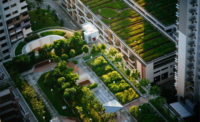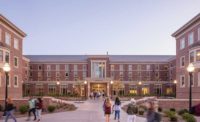The 50,200-square-foot Santa Monica City Hall East — a modern extension to the existing iconic and historic Art Deco-style City Hall — will be a one-stop-hub for the entire community to do business with the city while dramatically reducing off-site leasing costs for office space. Most notably, it aspires to be the greenest municipal building in the world.
The city leaders and project team behind this new civic resource have worked to achieve certification from the Living Building Challenge – one of the world’s most stringent green building rating systems. Conferred through the International Living Future Institute (ILFI), this certification requires that buildings must achieve net-zero energy and water — meaning the buildings produce as much as they consume — in addition to other environmental criteria.
Designed as an adaptable, supportive workplace, the City Services Building offers state-of-the-art work environments, including efficient office areas and collaboration zones. Passive design techniques maximize daylight, views, and natural ventilation to ensure occupant comfort while minimizing energy use. Additionally, the building is hardened against natural disasters and will serve as an essential public safety services center in the event of emergency. Buro Happold is providing integrated engineering and consulting services to ensure the new office building meets Living Building Challenge criteria, surpassing even the highest LEED-certification requirements.
Listen Now!
"The Seven Blooming Petals of the Living Building Challenge"
Heidi Creighton, associate principal, sustainability, Buro Happold, discusses the design work behind the Santa Monica City Hall East project and the facility’s quest to become Living Building Challenge certified.
In planning since 2014, the design provides a highly effective platform for delivering key services while ensuring a healthy, enjoyable work experience and service environment. Strategic use of daylight and natural ventilation enhance heating and cooling performance, reducing operating and maintenance costs and providing health and wellness benefits. Radiant tubing embedded throughout the open plan offices and meeting rooms efficiently heat and cool the space and optimize comfort. Phase-change material adds further effective thermal mass in lightweight partitions, absorbing heat by day and releasing it at night. Building electricity is supplied by photovoltaic rooftop arrays and solar shade structure photovoltaics arrays.
Three separate water strategies collectively allow all the building’s needs to be met by water harvested on-site. First, the projected water and sewer demand for the structure was cut by half with the introduction of a foam-based composting system for all the lavatories. The system’s units are located in the basement of the structure and require periodic maintenance. For potable water uses, rainwater from the roof is captured in a 40,000-gallon cistern located beneath the building; in drought conditions, the rainwater system is supplemented by groundwater pumped from a well drilled on-site. All rainwater and groundwater is treated with a combination of cartridge filters and granulated active carbon filters. Lastly, for nonpotable water uses, a system captures greywater and condensate from the cooling system’s air-handling units, which are treated via a moving bed-membrane bioreactor and used for on-site irrigation.
Designed to be a Living Building, the new facility will produce the energy and water it consumes on-site and serve as a model of Santa Monica’s commitment to both fiscal and environmental sustainability. Utility costs will be saved over the life of the building, and the facility will never have water or electric bills. The healthiest possible materials have been used in the construction of the new building, demonstrating Santa Monica’s commitment to public wellbeing.
Santa Monica's Living Building – City Services Building | Short Film (4K) from Prismedia LLC on Vimeo.
Taking advantage, the City of Santa Monica is leveraging existing resources by housing staff in its own resilient, green spaces designed for high functionality and long-term, low-cost ownership. This allows for greater return on investment and better service delivery from a 21st century government leader. The new facility consolidates about 240 city staff previously housed in private leased space spread throughout downtown Santa Monica, where tenant leases are expensive and expected to increase substantially for decades to come. Lease savings from relocations have financed the cost of the green bond issued to pay for the City Services Building. In less than 30 years, lease savings are projected to exceed the cost of financing the new construction. In addition, the building pays for itself well within its useful life of 100 years or more.
By incorporating the unique water systems and numerous other sustainable strategies into their design model, the Santa Monica City Services Building team has shown that the project is on track to secure Living Building Challenge’s certification — a measurable achievement and shining example of sustainable design. The architecture, engineering, and construction practices behind the City Services Building consider not only the environment and the challenge of climate change but also the human health aspect of government work and services while presenting an image of transparency and openness to the citizens it serves.
For lasting impact on the environment and the future of Santa Monica, the new City Services Building reflects the policies, operations, and work environments that contribute to a better future for both human and environmental health. Tracking certification under the Living Building Challenge has allowed city leadership to benchmark current performance and set goals for the coming years. These initiatives will show how visionary policy, good government, and architecture and engineering contribute to fiscal responsibility, lower energy use, reduced operational challenges, and greater quality of life for workers and for all city dwellers alike.
Santa Monica City Services Building (City Hall East)
Client: City of Santa Monica, Architecture Services Division; Department of Public Works
Architect: Frederick Fisher and Partners Architects
Contractor: Hathaway Dinwiddie Construction Company
Engineer: Buro Happold
Services provided by Buro Happold: MEP engineering, facades engineering, lighting, sustainability, Living Building consulting
Project value: $57 million
Duration: The project began in 2014 and is expected to be completed in 2020








